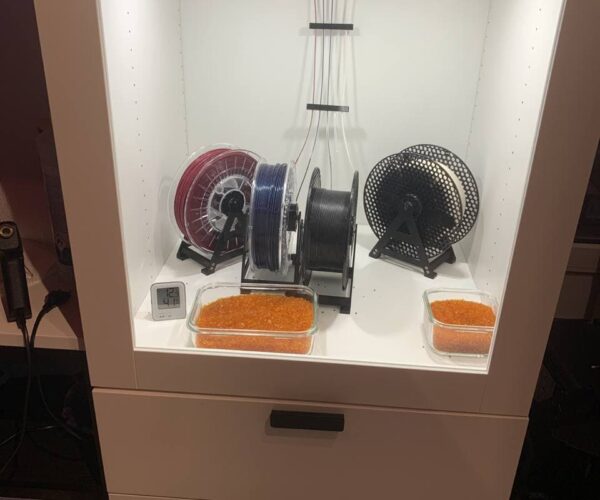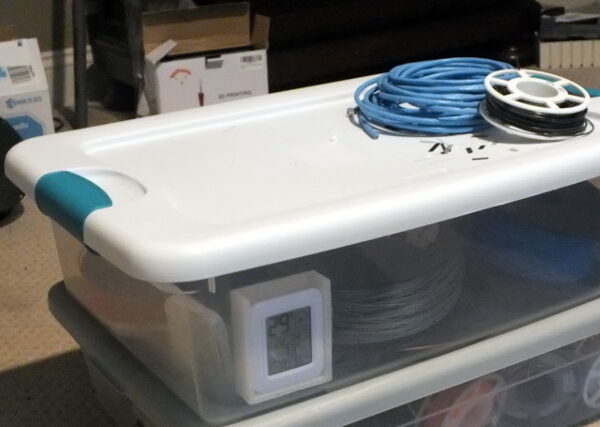Humidity in Dry Boxes
Hi.
What is the recommended humidity for dry boxes? Or what humidity do you guys have in your dry boxes?
Because my filament has its own compartment in my PLATSA enclosure my plan was to seal the door and don't use any dry boxes at all. Currently I get 41% humidity in the compartment, but I'm not sure if that's enough. What do you guys think?
Greetings
Saij
RE: Humidity in Dry Boxes
Lower is better. I typically can get my dry box down to about 15%, and don't let it go over 25%. But I only store nylons, TPU, and such in the box. PLA, PETG, and ABS are left out. I wouldn't even bother for 40%, unless you live in a tropical climate. I am in the midwest, and I average about 40%-50% in the house with the AC running. Winter much lower. Currently 12% in the house, but it is 5F (-15C) outside!
RE: Humidity in Dry Boxes
@hackmonkey
Just from a stand point of location matters. I would say 25% is not bad in humid climates. You are not gonna see much quality degration will you get over 30% for long periods of time. If your house is 10%, you dont need a box.
--------------------
Chuck H
3D Printer Review Blog
RE: Humidity in Dry Boxes
Well my living room shows around 50%-55% humidity. Don't know the value in my printer room, but I would think it is lower (and also it is way colder in there right now).
I hope to get around using a dry box when I can get the PLATSA enclosure more air tight and use a lot of silica gel.
RE: Humidity in Dry Boxes
That is why I only keep the nylon, and super sensitive stuff in a box. Winter is usually around 25% in the house. With the house averaging 40-50% over the year, PLA has to sit out about 10-12 months to have an issue, and then it is just brittle, still prints fine. Some PETG will have a noticeable change in print surface finish around 6-9 months, might notice popping around 10-12 months. But some PETG doesn't seem to care at all. TPU can have issues in as little as 2 months at 50%, in my experience/house.
RE: Humidity in Dry Boxes
I store my filament in a camera cabinet that reach 25%. It works at avoiding degradation. I guess I printed PEI, I might need lower levels. PETG and Nylon are fine at 25%.
--------------------
Chuck H
3D Printer Review Blog
RE: Humidity in Dry Boxes
Humid air is less dense than dry air [ https://www.theweatherprediction.com/habyhints/260/ ] , so with where your desiccant is located your filament may be saturated long before the silica. You should also mount the Hydrometer higher up in the cabinet for that exact same reason.
Also Since all of these measurements are RH, it's a bit of a crapshoot to state a specific RH% since RH relies so much on Temperature. 65F at 40%RH has the same moisture content per unit of air as 75F at 30%RH.
Rule of thumb I feel is to just keep it as dry as possible without hitting diminishing returns. Like if you can take down the RH by 20% with a small tub of silica but takes two more tubs to get down another 5%, I'd stop there.
RE: Humidity in Dry Boxes
Since I've had the Prusa, I have yet to have a failed print attributable to wet filament.
I keep the filaments I use regularly (and use up regularly) out on a rack above the printer and those I won't use for a while go in the dryboxes. I print a mix of PLA, ABS and PETg with an occasional PC Blend.
Of course the RH in the home office (where I have the printers) has been running 20-21 the past few days. In the summer it was up to the mid 30s.
Now, about a month ago I bought another printer, an Ultimaker, which normally uses the larger filament, but I've converted one extruder to 1.75. With it I got a few partly-used rolls of 2.85 PLA, all loose rolls, stored in the open from what I could see when I picked it up. The black 'tough PLA' is fine, but the white (the roll is almost all used) is brittle, and even snapped off when I did an unload. I suspect that one may be wet. It prints fine, however.
RE: Humidity in Dry Boxes
@cwbullet
I was just speaking in general terms here.
Using metric units since it's easier to read on the psychometric chart: At 20% RH, 1*C to 30*c, the physical amount of water in the air ranges from .9 to 5.22 grams of H2O/ kg of Dry Air. At 100% RH that range is 4 to 27 g/kg DA.
I don't know if there has been any long term studies about what Humidity & temperature levels will start damaging filament the fastest, though I do suspect it's very filament dependent (i.e Nylon will suck up water like no tomorrow while PLA just casually sips water from the air).
Doing some rough ballpark math here but say if we want a max 0.5% by weight humidity ratio (so 5 g/kg of dry air), at say 15C to 35C, you're looking at a RH range of about 45% at 15, 35% at 20C, 25% at 25C, 20% at 30C, and 15% at 35C. I rounded the numbers a bit to just make it easier to read (hence it also looks linear too).
Sorry a bit of rambling on in this post.

